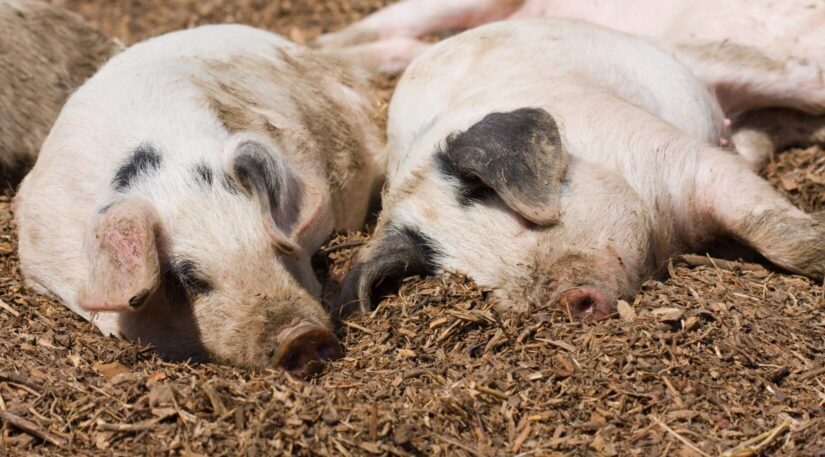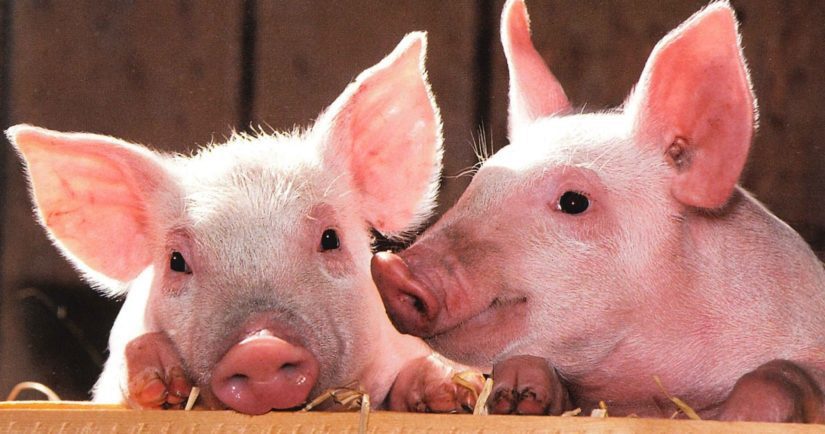The total number of pigs in Canada is estimated at 14.5 million animals. There are over 7,400 pig farms across Canada.
Life of a farmed pig
The first stage of the life of a market pig begins with gestation (pregnancy). Gilts (female pigs who have never had a litter of piglets before) reach maturity and are bred around five to seven months of age. Gestation lasts approximately 114 days (three months, three weeks and three days).
The next stage is farrowing (birth to weaning). After delivering their first litter of piglets, gilts are called sows. Gilts and sows are moved to a farrowing barn when they are ready to give birth (farrow). Sows will have around 12 to 13 piglets per litter. The sows nurse their piglets, who are weaned at about 21 days of age.
After weaning, piglets are moved to a nursery or a wean to finish barn, where they continue to grow. Once they are six to eight weeks of age, and weigh around 50 to 60 pounds, pigs are once again moved to what’s called a finishing barn to accommodate their growing size. If pigs are in a wean-to-finish barn, they remain there. At around five to six months of age, pigs will reach market weight of 280 pounds, and are ready to be sent to slaughter.

Welfare issues for farmed pigs
Painful practices
Castration, ear notching, tail-docking and teeth trimming are a few of the painful and stressful procedures piglets go through on a Canadian farm.
Male pigs are castrated before weaning to improve meat quality and to reduce aggression between other males. It is a painful and stressful process, but now pain control is a requirement for this procedure.
Ear notching is done for identification purposes, but is a painful process and there is no requirement for pain control when performed.
Pigs may be tail-docked in order to prevent tail-biting from occurring, which is a serious welfare problem. Tail-biting can be triggered by many different factors, such as lack of space and enrichment, and can result in severe wounds, infections and even death. Pain control is now required for tail docking procedures.
Piglets may have their teeth trimmed to help prevent pigs from injuring each other out of boredom or frustration in barns that lack space and enrichment. Although teeth clipping is not as commonly done on Canadian farms now, when it is performed there is no requirement for pain control, and if done improperly can lead to discomfort or infection.
More information on pain control requirements for pig procedures can be found in the Code of Practice for the Care and Handling of Pigs.
Housing
Pregnant pigs and sows that have recently given birth (farrowed) are often kept in “gestation stalls” and “farrowing crates”, which are usually about two feet wide by seven feet long (60 centimeters by 213 centimeters). In these stalls/crates, sows can lie down, stand up or sit, and may be able to take a step forward or backward; however, they do not have enough room to turn around. Stalls allow for increased control over each sow’s feed intake, can prevent aggression between sows, and restrict the movement of new moms in order to prevent them from lying on top of their piglets. However, sows are deprived of the ability to express important natural behaviours, leading to stress, frustration, and development of abnormal behaviours. Further, inability to exercise may lead to decreased bone and muscle strength.

Comfort
Pigs are commonly left to live on cold, damp, slatted floors. While these floors keep the barn cleaner by allowing manure and urine to fall through to a collection pit below, they don’t permit use of bedding for pig comfort and warmth. Hard, bare flooring may become slippery, and it increases leg sores and lameness (inability to walk properly) in pigs. Bedding not only allows pigs to be more comfortable, but also permits natural behaviours like rooting, exploration and nesting, and may reduce boredom and aggression in pigs.
Support a better life for farmed pigs
By choosing higher-welfare food products, you can help pigs lead better lives and support the farmers who care for them. Learn more about shopping for higher-welfare food.
We are always working to build a better future for farm animals in B.C. and across Canada, but we need your help. Help us speak for farm animals by taking action.

Additional resources:
Subscribe to FarmSense
Are you passionate about farm animal welfare and want to help improve the lives of pigs? Use this form to sign up for our FarmSense e-newsletter and stay up-to-date on our initiatives!

